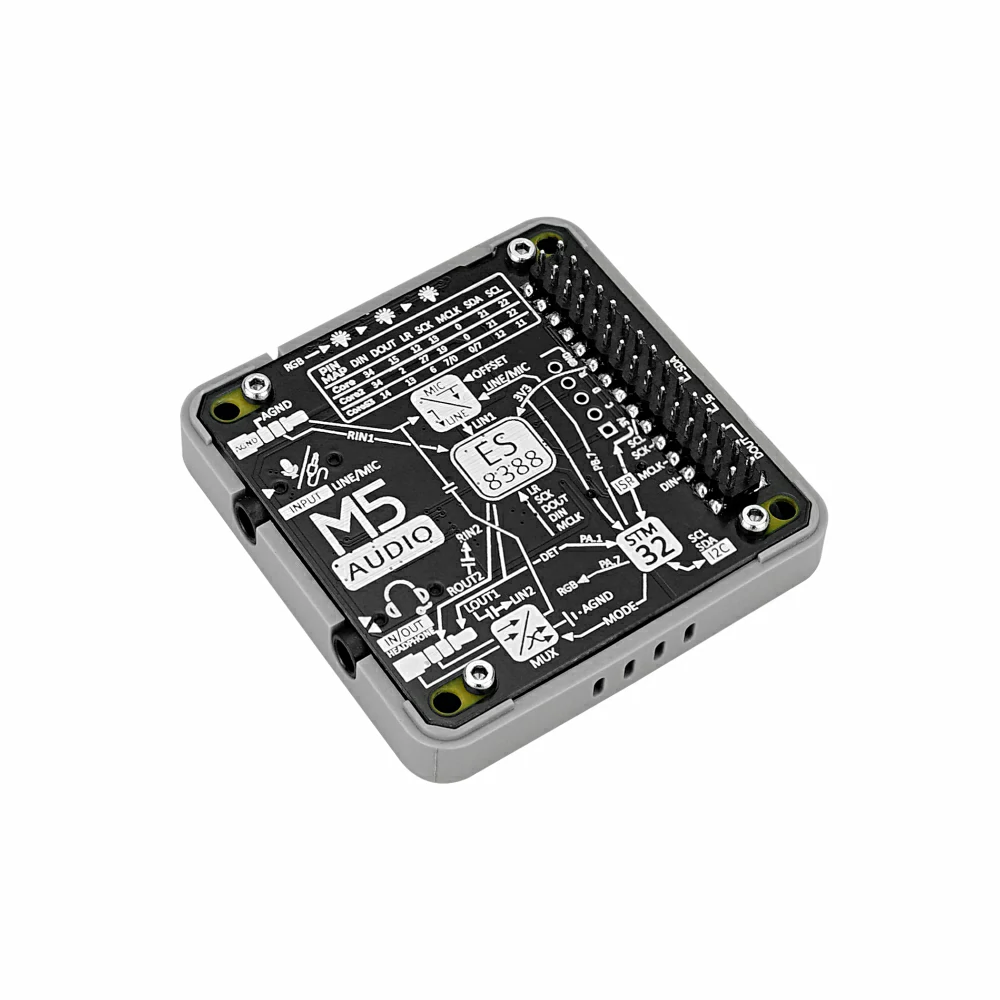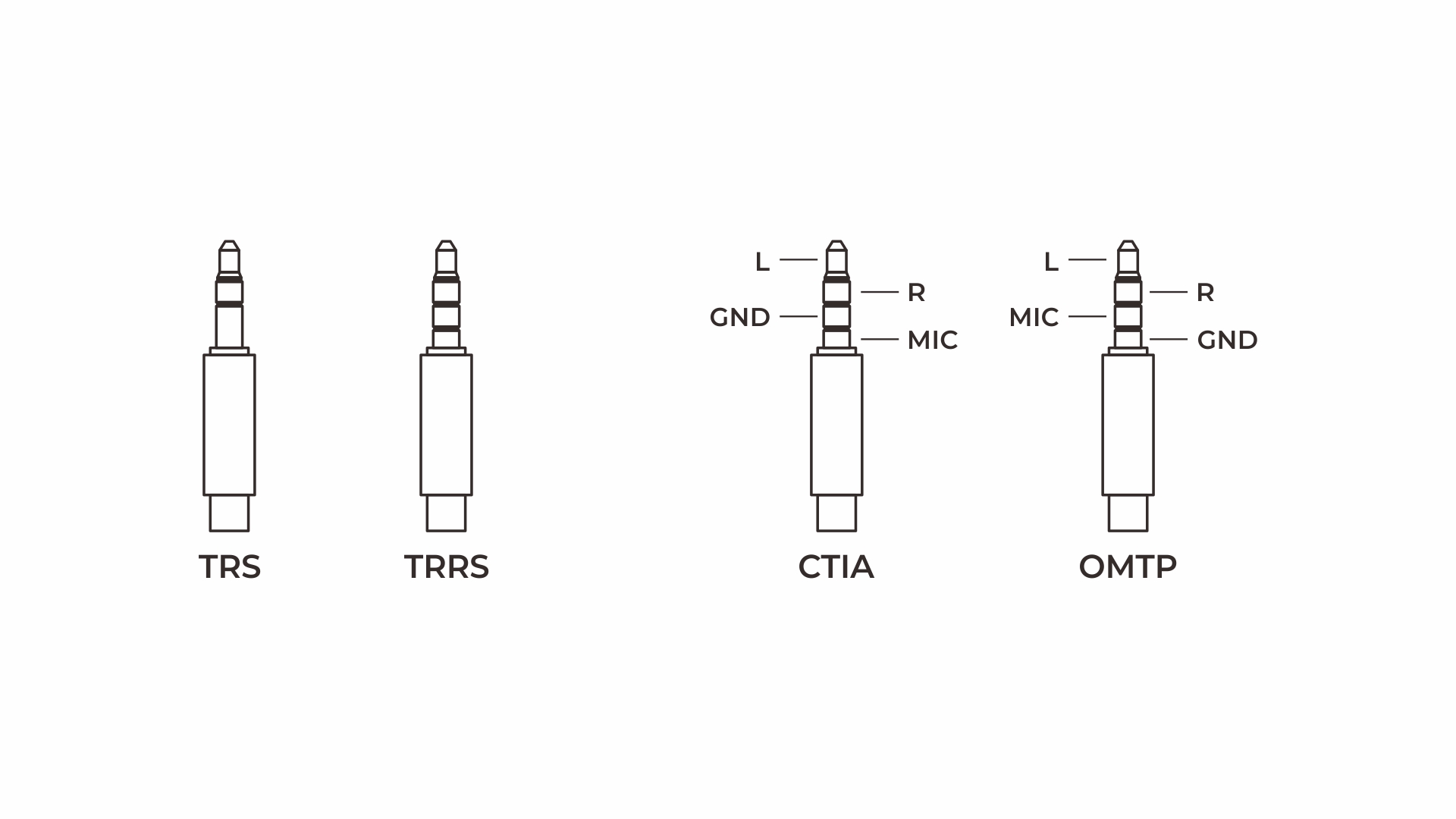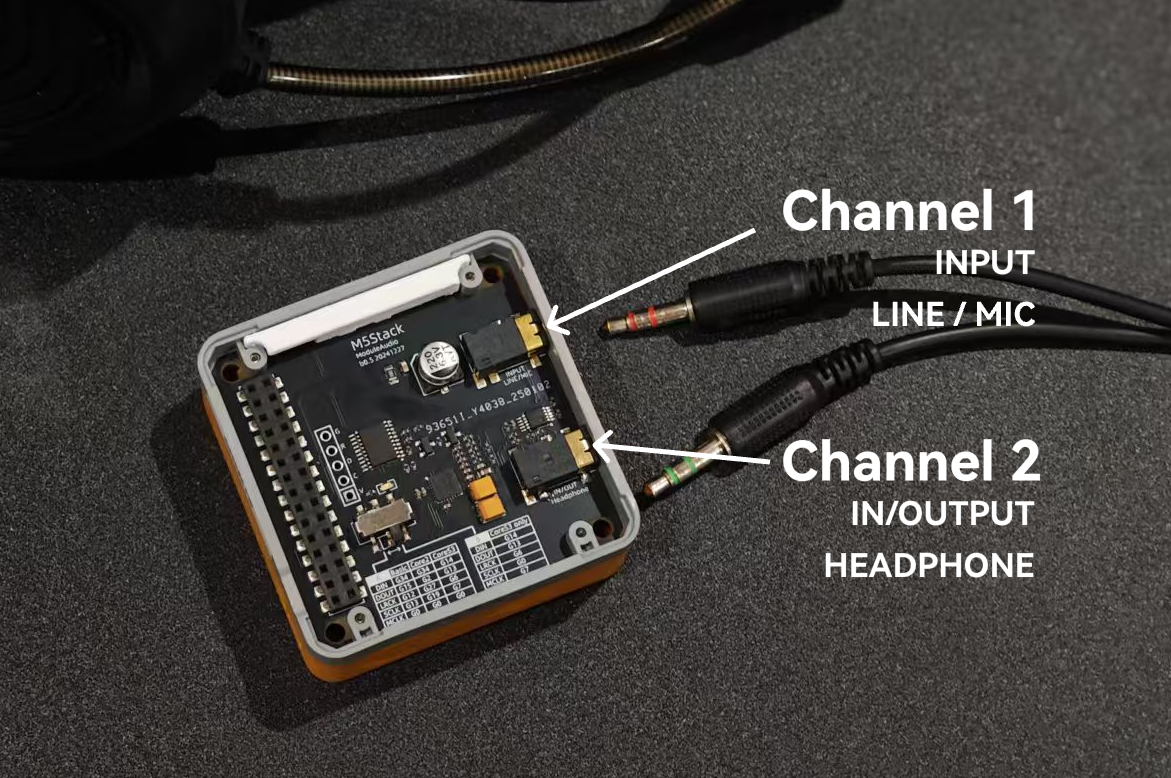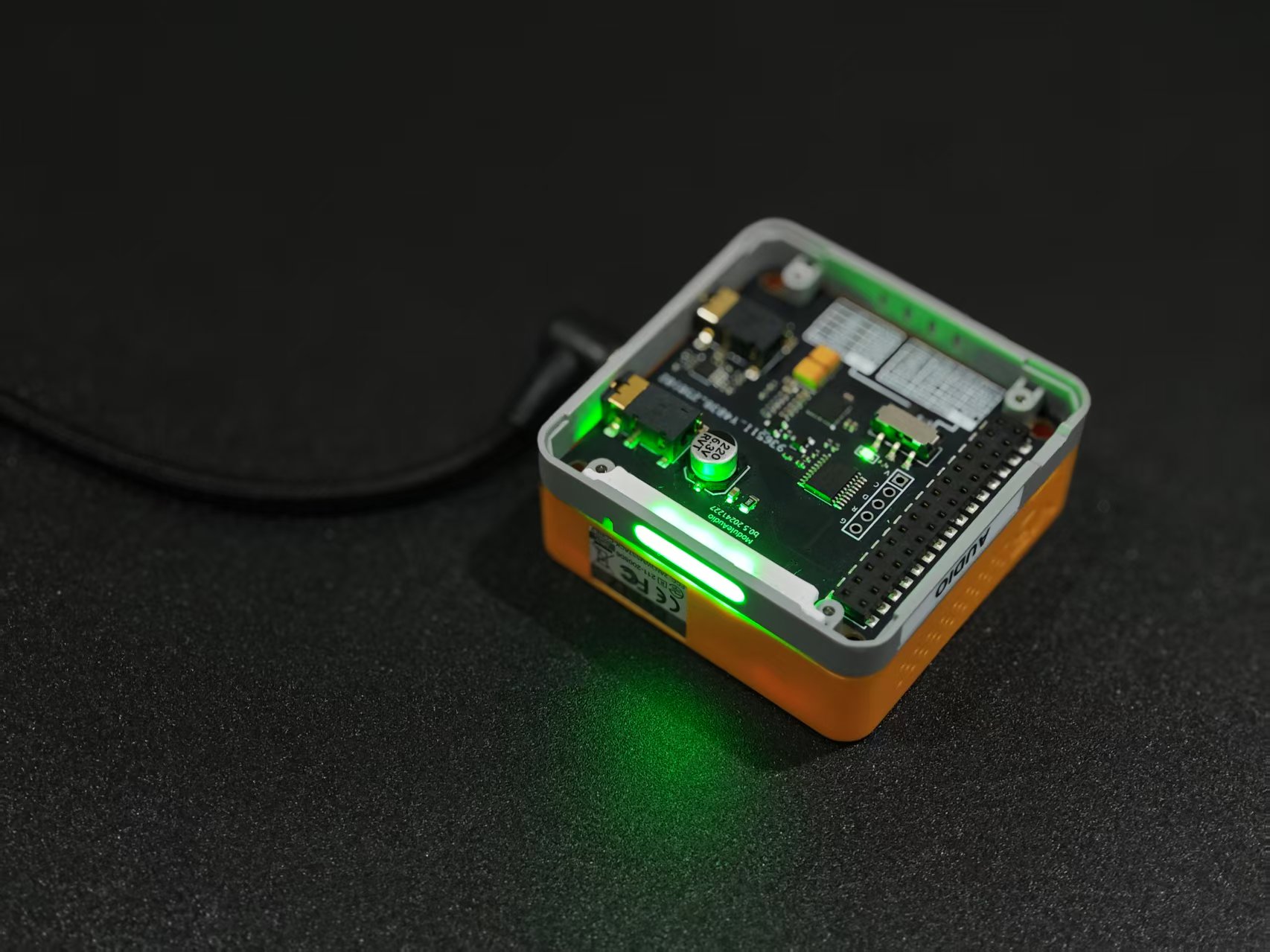Module Audio Arduino 使用教程
1.准备工作
1.环境配置: 参考Arduino IDE上手教程完成IDE安装, 并根据实际使用的开发板安装对应的板管理, 与需要的驱动库。
2.使用到的驱动库:
3.使用到的硬件产品:


2.初始化配置
Module Audio集成了STM32主控用于实现耳机接口标准切换,灯光控制,耳机插入检测(仅通道2可用),麦克风输入模式配置等功能。
接口标准选择
由于不同的耳机接口标准的所使用的线序不同,使用需根据实际情况使用
device.setHPMode(AUDIO_HPMODE_NATIONAL);函数切换耳机接口标准以实现兼容。OMTP(AUDIO_HPMODE_NATIONAL),CTIA(AUDIO_HPMODE_AMERICAN)。
cpp
1 2 3 4 5 6 7 8 9 10 11 12 13 14 15 16 17 18 19 20 21 22 23 24 25 26 27 28 29 30 31 32 33 34 35 36 37 38 39 40 41 42 43 44 45
#include "M5Unified.h"#include "audio_i2c.hpp"#include "es8388.hpp"#include "driver/i2s.h" #define SYS_I2C_SDA_PIN 21#define SYS_I2C_SCL_PIN 22#define SYS_I2S_MCLK_PIN 0#define SYS_I2S_SCLK_PIN 19#define SYS_I2S_LRCK_PIN 27#define SYS_I2S_DOUT_PIN 2#define SYS_I2S_DIN_PIN 34#define SYS_SPI_MISO_PIN 38#define SYS_SPI_MOSI_PIN 23#define SYS_SPI_CLK_PIN 18#define SYS_SPI_CS_PIN 4 AudioI2c device; ES8388 es8388(&Wire, SYS_I2C_SDA_PIN, SYS_I2C_SCL_PIN); void setup(){ M5.begin(); Serial.begin(115200); device.begin(&Wire, SYS_I2C_SCL_PIN, SYS_I2C_SCL_PIN); device.setHPMode(AUDIO_HPMODE_NATIONAL); // device.setHPMode(AUDIO_HPMODE_AMERICAN); device.setMICStatus(AUDIO_MIC_OPEN); device.setRGBBrightness(100); for (int i = 0; i <= 2; i++) { device.setRGBLED(i, 0x0000ff); }} void loop(){ bool isHPInsert = device.getHPInsertStatus(); if (isHPInsert) { Serial.println("Headphone Inserted"); } else { Serial.println("Headphone Removed"); } delay(500);}3.输入接口配置
接口使用说明
Module Audio配有两组3.5mm音频接口(通道1和通道2),其中通道1适用于3.5mm TRS音频信号接口的麦克风输入。通道2适用于3.5mm TRRS复合音频接口设备连接,同时也兼容TRS音频信号接口。

- TRS音频信号接口接线方式:通道1接入MIC输入,通道2接入音频输出。适用于麦克风与音频输出分离的设备,如电脑头戴耳机等。
- TRRS复合音频接口接线方式:通道2可接入复合音频输入输出,适用于带有麦克风的有线耳机,同时兼容TRS音频接口设备。

在完成初始化后,通过调用以下API配置输入输出接口通道选择与音量增益等参数。
cpp
1 2 3 4 5 6 7 8 9 10 11 12 13
// Use input 1 for both channelses8388.setADCInput(ADC_INPUT_LINPUT1_RINPUT1); // Use input 2 for both channels// es8388.setADCInput(ADC_INPUT_LINPUT2_RINPUT2); es8388.setDACOutput(DAC_OUTPUT_OUT1);es8388.setADCVolume(100);es8388.setDACVolume(40);es8388.setMicGain(MIC_GAIN_24DB);es8388.setMixSourceSelect(MIXADC, MIXADC);es8388.setBitsSample(ES_MODULE_ADC, BIT_LENGTH_16BITS);es8388.setSampleRate(SAMPLE_RATE_44K);4.录音和播放
使用TRS音频信号接口接线方式,配置通道1接入MIC输入,通道2音频输出,实现实时读取MIC输入数据和播放。
cpp
1 2 3 4 5 6 7 8 9 10 11 12 13 14 15 16 17 18 19 20 21 22 23 24 25 26 27 28 29 30 31 32 33 34 35 36 37 38 39 40 41 42 43 44 45 46 47 48 49 50 51 52 53 54 55 56 57 58 59 60 61 62 63 64 65 66 67 68 69 70 71 72 73 74 75 76 77 78 79 80 81 82 83 84 85 86 87 88 89 90 91 92
#include "M5Unified.h"#include "audio_i2c.hpp"#include "es8388.hpp"#include "driver/i2s.h"AudioI2c device; #define SYS_I2C_SDA_PIN 21#define SYS_I2C_SCL_PIN 22#define SYS_I2S_MCLK_PIN 0#define SYS_I2S_SCLK_PIN 19#define SYS_I2S_LRCK_PIN 27#define SYS_I2S_DOUT_PIN 2#define SYS_I2S_DIN_PIN 34#define SYS_SPI_MISO_PIN 38#define SYS_SPI_MOSI_PIN 23#define SYS_SPI_CLK_PIN 18#define SYS_SPI_CS_PIN 4 ES8388 es8388(&Wire, SYS_I2C_SDA_PIN, SYS_I2C_SCL_PIN); uint16_t rxbuf[256], txbuf[256];size_t readsize = 0;byte error, address;const uint32_t color[] = {0xFF0000, 0xFF0000, 0xFF0000, 0x00FF00, 0xFFFF00, 0xFFFFFF, 0xFFFFFF, 0xFFFFFF, 0xFFFFFF};i2s_config_t i2s_config = {.mode = (i2s_mode_t)(I2S_MODE_MASTER | I2S_MODE_TX | I2S_MODE_RX), .sample_rate = 44100, .bits_per_sample = I2S_BITS_PER_SAMPLE_16BIT, .channel_format = I2S_CHANNEL_FMT_RIGHT_LEFT, .communication_format = I2S_COMM_FORMAT_STAND_I2S, .intr_alloc_flags = 0, .dma_buf_count = 8, .dma_buf_len = 512, .use_apll = false, .tx_desc_auto_clear = true, .fixed_mclk = 0}; i2s_pin_config_t pin_config = { .mck_io_num = SYS_I2S_MCLK_PIN, .bck_io_num = SYS_I2S_SCLK_PIN, .ws_io_num = SYS_I2S_LRCK_PIN, .data_out_num = SYS_I2S_DOUT_PIN, .data_in_num = SYS_I2S_DIN_PIN,}; void setup(){ M5.begin(); Serial.begin(115200); device.begin(&Wire, SYS_I2C_SCL_PIN, SYS_I2C_SCL_PIN); device.setHPMode(AUDIO_HPMODE_NATIONAL); device.setMICStatus(AUDIO_MIC_OPEN); device.setRGBBrightness(100); Serial.printf("getHPMode:%d\n", device.getHPMode()); Serial.printf("getMICStatus:%d\n", device.getMICStatus()); for (int i = 0; i <= 2; i++) { device.setRGBLED(i, color[i + 3]); // Output the hexadecimal value of the current color Serial.printf("Set RGB to %06X\n", (unsigned int)color[i + 3]); Serial.printf("get RGB to %06X\n", device.getRGBLED(i)); } Serial.println("Read Reg ES8388 : "); if (!es8388.init()) Serial.println("Init Fail"); es8388.setADCInput(ADC_INPUT_LINPUT1_RINPUT1); es8388.setMicGain(MIC_GAIN_24DB); es8388.setADCVolume(100); // The volume output should not exceed 40, otherwise there will be noise or current sounds es8388.setDACVolume(40); es8388.setDACOutput(DAC_OUTPUT_OUT1); es8388.setMixSourceSelect(MIXADC, MIXADC); es8388.setBitsSample(ES_MODULE_ADC, BIT_LENGTH_16BITS); es8388.setSampleRate(SAMPLE_RATE_44K); uint8_t *reg; for (uint8_t i = 0; i < 53; i++) { reg = es8388.readAllReg(); Serial.printf("Reg-%02d = 0x%02x\r\n", i, reg[i]); } // i2s i2s_driver_install(I2S_NUM_0, &i2s_config, 0, NULL); i2s_set_pin(I2S_NUM_0, &pin_config);} void loop(){ i2s_read(I2S_NUM_0, &rxbuf[0], 256 * 2, &readsize, 1000); for (int i = 0; i < 256; i++) { // direct transfer too txbuff txbuf[i] = rxbuf[i]; // txbuf[i] = 0; //mute } // play received buffer i2s_write(I2S_NUM_0, &txbuf[0], 256 * 2, &readsize, 1000);}5.播放MicroSD WAV
配置通道2音频输出,加载MicroSD卡中存储的WAV文件,并进行播放。使用前需添加wav文件至MicroSD卡,并插入至主控设备卡槽中。
cpp
1 2 3 4 5 6 7 8 9 10 11 12 13 14 15 16 17 18 19 20 21 22 23 24 25 26 27 28 29 30 31 32 33 34 35 36 37 38 39 40 41 42 43 44 45 46 47 48 49 50 51 52 53 54 55 56 57 58 59 60 61 62 63 64 65 66 67 68 69 70 71 72 73 74 75 76 77 78 79 80 81 82 83 84 85 86 87 88 89 90 91 92 93 94 95 96 97 98 99 100 101 102 103 104 105 106 107 108 109 110 111 112 113 114 115 116 117 118 119 120 121 122 123 124 125 126 127 128 129 130 131 132 133 134 135 136 137 138
#include "M5Unified.h"#include "audio_i2c.hpp"#include "es8388.hpp"#include "driver/i2s.h"#include <SPI.h>#include <SD.h>AudioI2c device; #define SYS_I2C_SDA_PIN 21#define SYS_I2C_SCL_PIN 22#define SYS_I2S_MCLK_PIN 0#define SYS_I2S_SCLK_PIN 19#define SYS_I2S_LRCK_PIN 27#define SYS_I2S_DOUT_PIN 2#define SYS_I2S_DIN_PIN 34#define SYS_SPI_MISO_PIN 38#define SYS_SPI_MOSI_PIN 23#define SYS_SPI_CLK_PIN 18#define SYS_SPI_CS_PIN 4 ES8388 es8388(&Wire, SYS_I2C_SDA_PIN, SYS_I2C_SCL_PIN);void i2s_write_task(void *arg);uint16_t rxbuf[256], txbuf[256];size_t readsize = 0;byte error, address;const uint32_t color[] = {0xFF0000, 0xFF0000, 0xFF0000, 0x00FF00, 0xFFFF00, 0xFFFFFF, 0xFFFFFF, 0xFFFFFF, 0xFFFFFF};i2s_config_t i2s_config = {.mode = (i2s_mode_t)(I2S_MODE_MASTER | I2S_MODE_TX | I2S_MODE_RX), .sample_rate = 44100, .bits_per_sample = I2S_BITS_PER_SAMPLE_16BIT, .channel_format = I2S_CHANNEL_FMT_RIGHT_LEFT, .communication_format = I2S_COMM_FORMAT_STAND_I2S, .intr_alloc_flags = 0, .dma_buf_count = 8, .dma_buf_len = 512, .use_apll = false, .tx_desc_auto_clear = true, .fixed_mclk = 0}; i2s_pin_config_t pin_config = { .mck_io_num = SYS_I2S_MCLK_PIN, .bck_io_num = SYS_I2S_SCLK_PIN, .ws_io_num = SYS_I2S_LRCK_PIN, .data_out_num = SYS_I2S_DOUT_PIN, .data_in_num = SYS_I2S_DIN_PIN,}; void setup(){ M5.begin(); Serial.begin(115200); device.begin(&Wire, SYS_I2C_SCL_PIN, SYS_I2C_SCL_PIN); device.setHPMode(AUDIO_HPMODE_NATIONAL); device.setMICStatus(AUDIO_MIC_OPEN); device.setRGBBrightness(100); Serial.printf("getHPMode:%d\n", device.getHPMode()); Serial.printf("getMICStatus:%d\n", device.getMICStatus()); for (int i = 0; i <= 2; i++) { device.setRGBLED(i, color[i + 3]); // Output the hexadecimal value of the current color Serial.printf("Set RGB to %06X\n", (unsigned int)color[i + 3]); Serial.printf("get RGB to %06X\n", device.getRGBLED(i)); } Serial.println("Read Reg ES8388 : "); if (!es8388.init()) Serial.println("Init Fail"); es8388.setADCVolume(100); es8388.setDACVolume(80); es8388.setDACOutput(DAC_OUTPUT_OUT1); es8388.setMixSourceSelect(MIXADC, MIXADC); es8388.setBitsSample(ES_MODULE_ADC, BIT_LENGTH_16BITS); es8388.setSampleRate(SAMPLE_RATE_44K); uint8_t *reg; for (uint8_t i = 0; i < 53; i++) { reg = es8388.readAllReg(); Serial.printf("Reg-%02d = 0x%02x\r\n", i, reg[i]); } // i2s i2s_driver_install(I2S_NUM_0, &i2s_config, 0, NULL); i2s_set_pin(I2S_NUM_0, &pin_config); if (SD.begin(SYS_SPI_CS_PIN)) { Serial.println("SD card initialized successfully"); } else { Serial.println("Failed to initialize SD card. Retrying..."); } xTaskCreate(i2s_write_task, "i2s_write_task", 1024 * 8, NULL, 6, NULL);} void loop(){} void i2s_write_task(void *arg){ // Open the WAV file // Replace with the path of your WAV file File file = SD.open("/hello.wav", "r"); if (!file) { Serial.println("Failed to open WAV file for reading"); vTaskDelete(NULL); } // Obtain the file size and print size_t fileSize = file.size(); Serial.printf("File size: %d bytes\n", fileSize); // Skip the WAV file header (44 bytes) file.seek(44); uint8_t txbuf[1024]; while (1) { // Check whether the end of the file has been reached if (file.available() == 0) { // Go back to the beginning of the file in order to replay it file.seek(44); } // Read data size_t bytesRead = file.read(txbuf, sizeof(txbuf)); // If data is read if (bytesRead > 0) { size_t bytesWritten = 0; esp_err_t result = i2s_write(I2S_NUM_0, txbuf, bytesRead, &bytesWritten, portMAX_DELAY); // Check the writing result if (result != ESP_OK) { Serial.printf("I2S write error: %d\n", result); } } else { // If there is no more data, exit the loop break; } } // Close the file file.close(); vTaskDelete(NULL);}6.RGB LED控制
Module Audio侧边集成了3颗可编程RGB LED,可参考以下案例进行控制。
cpp
1 2 3 4 5 6 7 8 9 10 11 12 13 14 15 16 17 18 19 20 21 22 23 24 25 26 27 28 29 30 31 32 33 34 35 36 37
#include "M5Unified.h"#include "audio_i2c.hpp"#include "es8388.hpp"#include "driver/i2s.h" #define SYS_I2C_SDA_PIN 21#define SYS_I2C_SCL_PIN 22 AudioI2c device; void setup(){ M5.begin(); Serial.begin(115200); Serial.println("Module Audio Init..."); while (!device.begin(&Wire, SYS_I2C_SDA_PIN, SYS_I2C_SCL_PIN)) { delay(1000); }; Serial.println("Module Audio Init OK!"); device.setRGBBrightness(100);} void loop(){ for (int i = 0; i <= 2; i++) { device.setRGBLED(i, 0xff0000); } delay(1000); for (int i = 0; i <= 2; i++) { device.setRGBLED(i, 0x00ff00); } delay(1000); for (int i = 0; i <= 2; i++) { device.setRGBLED(i, 0x0000ff); } delay(1000);}
